Burt A. The Evolution of the British Empire and Commonwealth From the American Revolution
Подождите немного. Документ загружается.

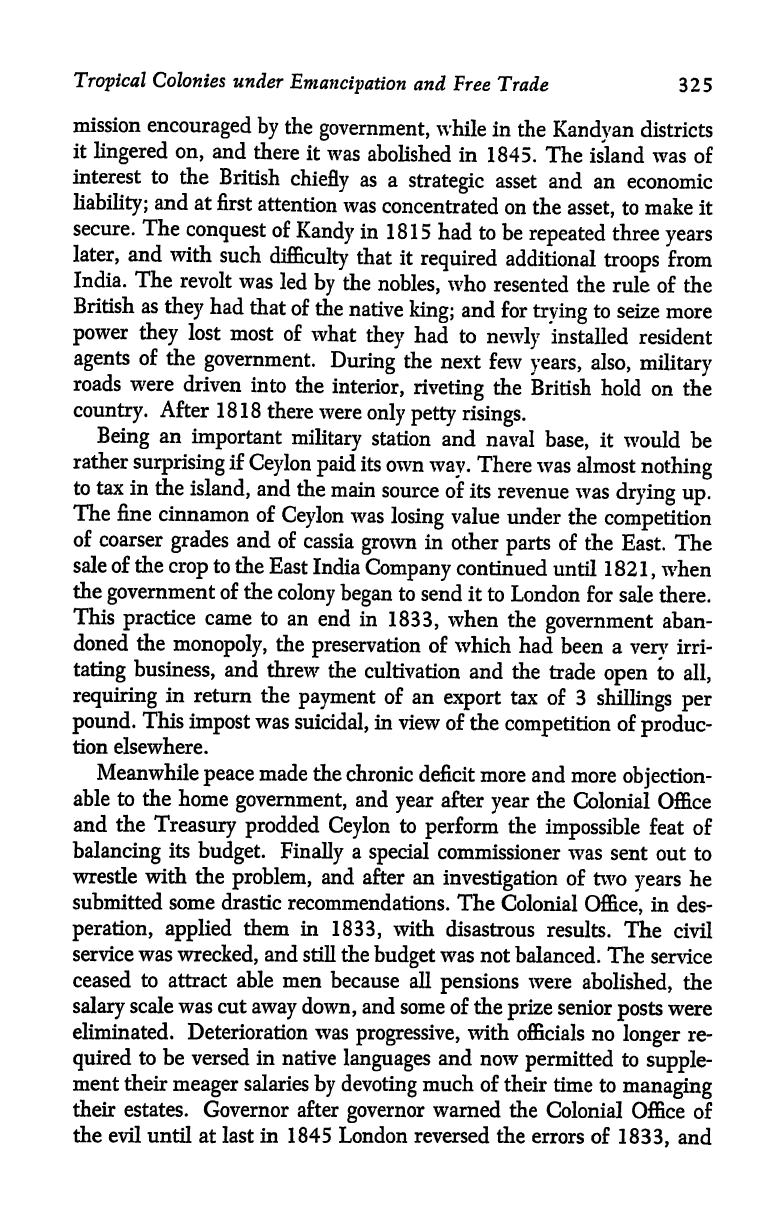
Tropical
Colonies
under
Emancipation
and
Free
Trade
325
mission
encouraged
by
the
government,
while in
the
Kandyan
districts
it
lingered
on,
and
there
it
was
abolished in
1845.
The
island was
of
interest to
the
British
chiefly
as
a
strategic
asset
and an
economic
liability;
and
at
first
attention
was
concentrated
on the
asset,
to
make
it
secure. The
conquest
of
Kandy
in
1815
had to
be
repeated
three
years
later,
and
with
such
difficulty
that it
required
additional
troops
from
India. The
revolt
was
led
by
the
nobles,
who
resented the
rule
of the
British
as
they
had
that
of
the
native
king;
and for
trying
to seize
more
power they
lost
most
of
what
they
had to
newly
installed
resident
agents
of
the
government.
During
the
next
few
years,
also,
military
roads were
driven
into
the
interior,
riveting
the
British
hold
on
the
country.
After
1818
there
were
only
petty
risings.
Being
an
important
military
station
and
naval
base,
it
would
be
rather
surprising
if
Ceylon
paid
its
own
way.
There
was
almost
nothing
to
tax
in
the
island,
and
the
main
source
of
its
revenue was
drying up.
The
fine
cinnamon
of
Ceylon
was
losing
value
under
the
competition
of coarser
grades
and
of
cassia
grown
in
other
parts
of
the
East.
The
sale of
the
crop
to
the
East India
Company
continued
until
1821,
when
the
government
of the
colony
began
to
send it
to
London
for
sale
there.
This
practice
came
to an
end in
1833,
when
the
government
aban-
doned
the
monopoly,
the
preservation
of
which
had
been a
very
irri-
tating
business,
and
threw
the
cultivation
and
the
trade
open
to
all,
requiring
in
return
the
payment
of an
export
tax
of 3
shillings per
pound.
This
impost
was
suicidal,
in
view
of the
competition
of
produc-
tion elsewhere.
Meanwhile
peace
made
the
chronic
deficit more
and
more
objection-
able
to
the
home
government,
and
year
after
year
the
Colonial
Office
and the
Treasury
prodded
Ceylon
to
perform
the
impossible
feat
of
balancing
its
budget.
Finally
a
special
commissioner was
sent
out
to
wrestle
with
the
problem,
and after
an
investigation
of
two
years
he
submitted
some
drastic
recommendations.
The
Colonial
Office,
in
des-
peration,
applied
them
in
1833,
with
disastrous
results.
The
civil
service
was
wrecked,
and still the
budget
was not
balanced.
The
service
ceased to attract able
men
because
all
pensions
were
abolished,
the
salary
scale
was
cut
away
down,
and some of
the
prize
senior
posts
were
eliminated. Deterioration was
progressive,
with
officials
no
longer
re-
quired
to
be versed
in
native
languages
and now
permitted
to
supple-
ment their
meager
salaries
by
devoting
much
of their
time to
managing
their estates.
Governor after
governor
warned
the
Colonial
Office
of
the evil
until
at
last
in
1845 London
reversed the
errors
of
1833,
and
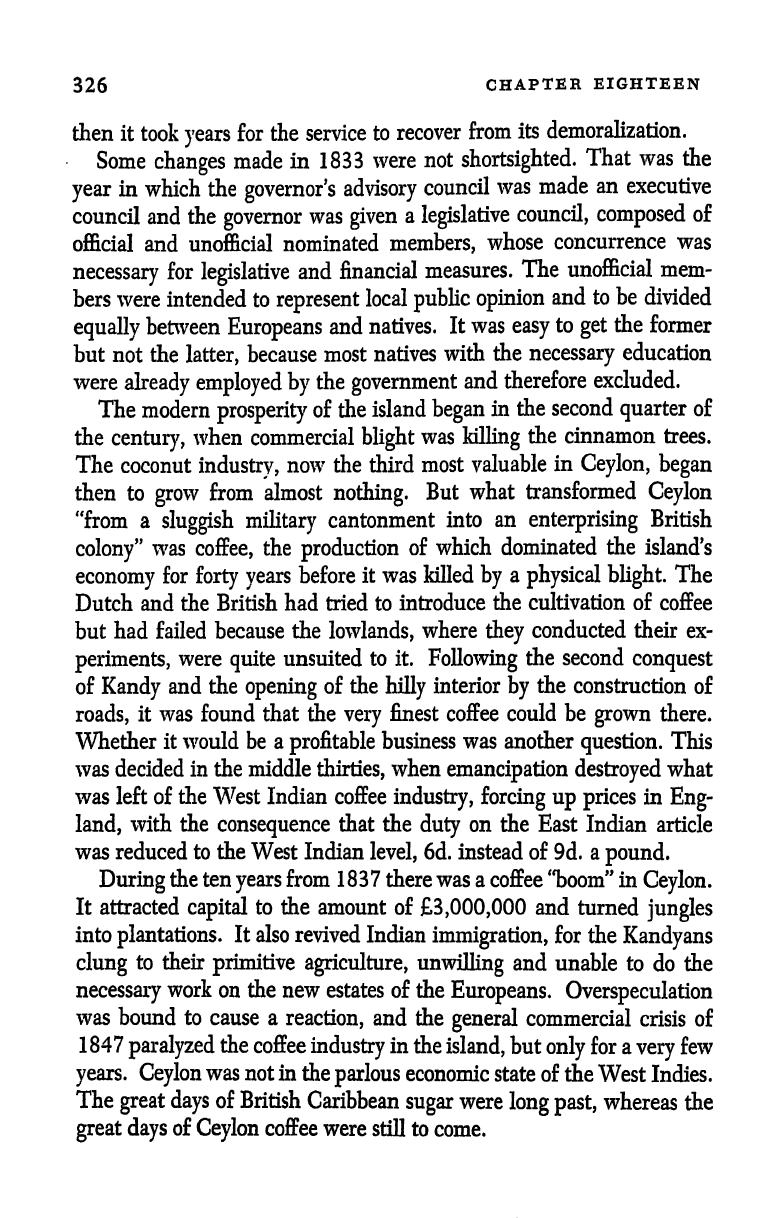
326
CHAPTER
EIGHTEEN
then
it
took
years
for
the service
to
recover
from
its
demoralization.
Some
changes
made in
1833
were
not
shortsighted.
That was
the
year
in
which
the
governor's
advisory
council
was
made
an
executive
council and
the
governor
was
given
a
legislative
council,
composed
of
official and
unofficial
nominated
members,
whose
concurrence
was
necessary
for
legislative
and
financial
measures.
The
unofficial
mem-
bers were
intended to
represent
local
public
opinion
and to
be
divided
equally
between
Europeans
and
natives.
It
was
easy
to
get
the
former
but
not the
latter,
because
most
natives
with the
necessary
education
were
already
employed
by
the
government
and
therefore
excluded.
The modern
prosperity
of
the
island
began
in
the
second
quarter
of
the
century,
when
commercial
blight
was
lolling
the
cinnamon
trees.
The coconut
industry,
now
the third
most valuable
in
Ceylon,
began
then to
grow
from
almost
nothing.
But
what
transformed
Ceylon
"from a
sluggish
military
cantonment
into
an
enterprising
British
colony"
was
coffee,
the
production
of which dominated
the
island's
economy
for
forty years
before
it
was
killed
by
a
physical
blight.
The
Dutch and
the
British had tried to
introduce
the cultivation of
coffee
but
had
failed because
the
lowlands,
where
they
conducted
their
ex-
periments,
were
quite
unsuited
to it.
Following
the second
conquest
of
Kandy
and the
opening
of the
hilly
interior
by
the
construction
of
roads,
it was found
that
the
very
finest
coffee could
be
grown
there.
Whether
it would be a
profitable
business
was
another
question.
This
was decided
in the
middle
thirties,
when
emancipation destroyed
what
was left of
the
West
Indian coffee
industry, forcing up
prices
in
Eng-
land,
with the
consequence
that the
duty
on the
East
Indian
article
was
reduced to
the
West
Indian
level,
6d. instead of
9d.
a
pound.
During
the ten
years
from 1837
there was a coffee
"boom"
in
Ceylon.
It attracted
capital
to the
amount of
3,000,000
and
turned
jungles
into
plantations.
It also revived Indian
immigration,
for the
Kandyans
clung
to
their
primitive
agriculture,
unwilling
and
unable
to do
the
necessary
work on the
new estates of the
Europeans.
Overspeculation
was bound to cause a
reaction,
and
the
general
commercial crisis of
1847
paralyzed
the
coffee
industry
in
the
island,
but
only
for a
very
few
years. Ceylon
was not in
the
parlous
economic state
of the
West
Indies.
The
great
days
of
British
Caribbean
sugar
were
long past,
whereas the
great
days
of
Ceylon
coffee
were
still
to
come.
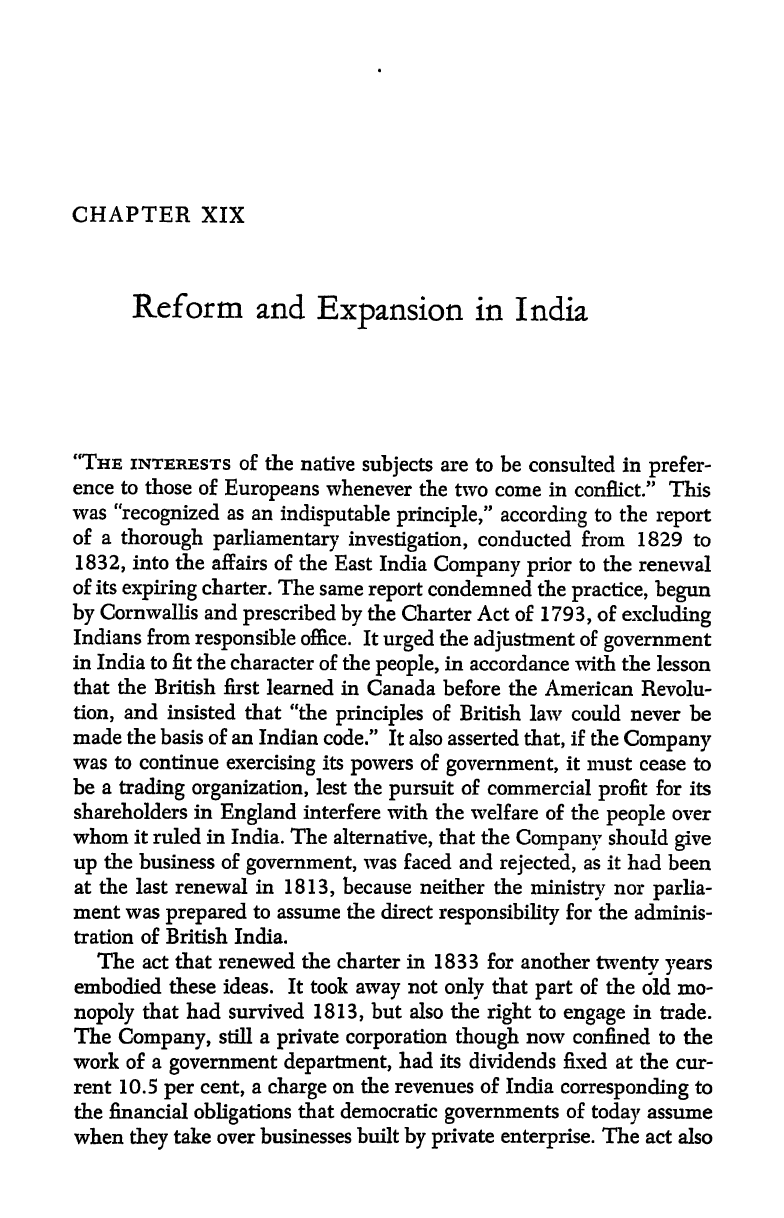
CHAPTER
XIX
Reform
and
Expansion
in
India
"THE
INTERESTS
of
the
native
subjects
are
to be
consulted in
prefer-
ence to
those
of
Europeans
whenever
the
two
come
in
conflict."
This
was
"recognized
as
an
indisputable
principle,"
according
to the
report
of
a
thorough
parliamentary
investigation,
conducted
from 1829
to
1832,
into the
affairs of
the East
India
Company prior
to
the
renewal
of its
expiring
charter.
The
same
report
condemned
the
practice,
begun
by
Cornwallis and
prescribed
by
the Charter
Act of
1793,
of
excluding
Indians
from
responsible
office.
It
urged
the
adjustment
of
government
in India to
fit the
character
of the
people,
in
accordance with the
lesson
that
the
British
first
learned in
Canada before the
American
Revolu-
tion,
and
insisted that
"the
principles
of British
law could never
be
made
the
basis of an
Indian
code."
It
also
asserted
that,
if the
Company
was to continue
exercising
its
powers
of
government,
it must
cease
to
be
a
trading organization,
lest the
pursuit
of
commercial
profit
for
its
shareholders
in
England
interfere
with the
welfare of
the
people
over
whom
it
ruled
in
India. The
alternative,
that
the
Company
should
give
up
the
business of
government,
was faced
and
rejected,
as it
had
been
at the last renewal in
1813,
because
neither the
ministry
nor
parlia-
ment was
prepared
to
assume
the
direct
responsibility
for
the
adminis-
tration of British India.
The
act
that renewed
the
charter in 1833
for another
twenty years
embodied
these
ideas. It took
away
not
only
that
part
of the
old mo-
nopoly
that had survived
1813,
but also
the
right
to
engage
in
trade.
The
Company,
still a
private
corporation
though
now
confined to the
work of
a
government
department,
had its
dividends
fixed at
the
cur-
rent 10.5
per
cent,
a
charge
on
the revenues of
India
corresponding
to
the financial
obligations
that
democratic
governments
of
today
assume
when
they
take
over
businesses
built
by private enterprise.
The
act
also

328
CHAPTER
NINETEEN:
provided
for
the
codification
of Indian
law,
which was to
take
account
of
"the
rights,
feelings
and
peculiar usages
of
the
people,"
for
which
purpose
it
added
a
fourth
member,
a
legal
one,
to
the
governor
general's
council;
and for
greater
efficiency
of administration it
made
the
gover-
nor
general
supreme
over the
presidencies
of
Bombay
and
Madras,
and
conferred
upon
him,
when
acting
with
his
council,
full
power
to
enact
laws
for
the
whole of British India.
Of
course he
was
still
under
the
sovereignty
of
parliament
and
subject
to orders
from
the
Court
of
Direc-
tors,
who in
turn
had
to bow to
the
will of
the
President
of
the
Board
of
Control,
the
minister
of the
Crown
who
was
responsible
for
the
Indian
Empire
as the
colonial
secretary
was
for
the
colonies.
In
addi-
tion
to
what
it
did for
the
unfication
of
India,
the
act
laid
down
the
famous
rule "that
no
native of
India,
nor
any
natural-born
subject
of
His
Majesty,
should be
disabled
from
holding any
place,
office,
or
em-
ployment,
by
reason
of his
religion,
place
of
birth,
descent
or
color."
The
Charter
Act
of
1833
was
one
of
the
first
reform
measures
of
the
reformed
parliament,
but it
did not
inaugurate
a
reform
era
in
India.
This
had
already
begun
there
years
before,
with
the
organization
of
the
extensive
territories
conquered
during
the
Napoleonic
period
and
shortly
afterward.
It
was
the
work
of a
remarkable
group
of
brilliant
officials,
military
as
well
as
civilian,
who
devoted
their
talents
to
the
land
and its
people:
men
like
Mountstuart
Elphinstone,
the
pacifier
of
the
provinces
of
the
former
peshwa,
the
creative
governor
of
Bombay,
and the
author
of a
classic
history
of
India;
or
Sir
Thomas
Munro,
whose
ryotwari
settlement,
with
its
direct
dealings
between
government
and
peasant,
gave
the
Presidency
of
Madras a
land
revenue
system
far
superior
to
that
of
Bengal,
with
its
zamindar
intermediaries;
or
Sir
Charles
Metcalfe,
who
established
order
in
the
North-West
Provinces.
All
three
were
covenanted
servants
of
the
Company
who
rose
to
be
governors,
a
rank
usually
filled,
like
the
office
of
governor
general,
by
outside
appointment
in
England
with
the
object
of
getting
men
of
out-
standing
ability
and
independent
position;
and it
is
worthy
of
note
that
at
the
end
of
their
careers
in
India,
Metcalfe
became
governor
general
for
a
short
while
and
Elphinstone
was
offered
the
succession
but
had
to
refuse it
because
his
health
was
broken.
Men
of
this
type
were
beginning
to
distinguish
the
covenanted
serv-
ice
of the
Company
by
1800;
and
after
the
fall
of
Napoleon,
when
reaction
was
at
its
height
in
England
as
well
as
on
the
continent,
the
liberal-minded
Marquis
of
Hastings
was a
reforming
governor
general.
He
reversed the
Cornwallis
policy
of
refusing
to
employ
Indians
in
any
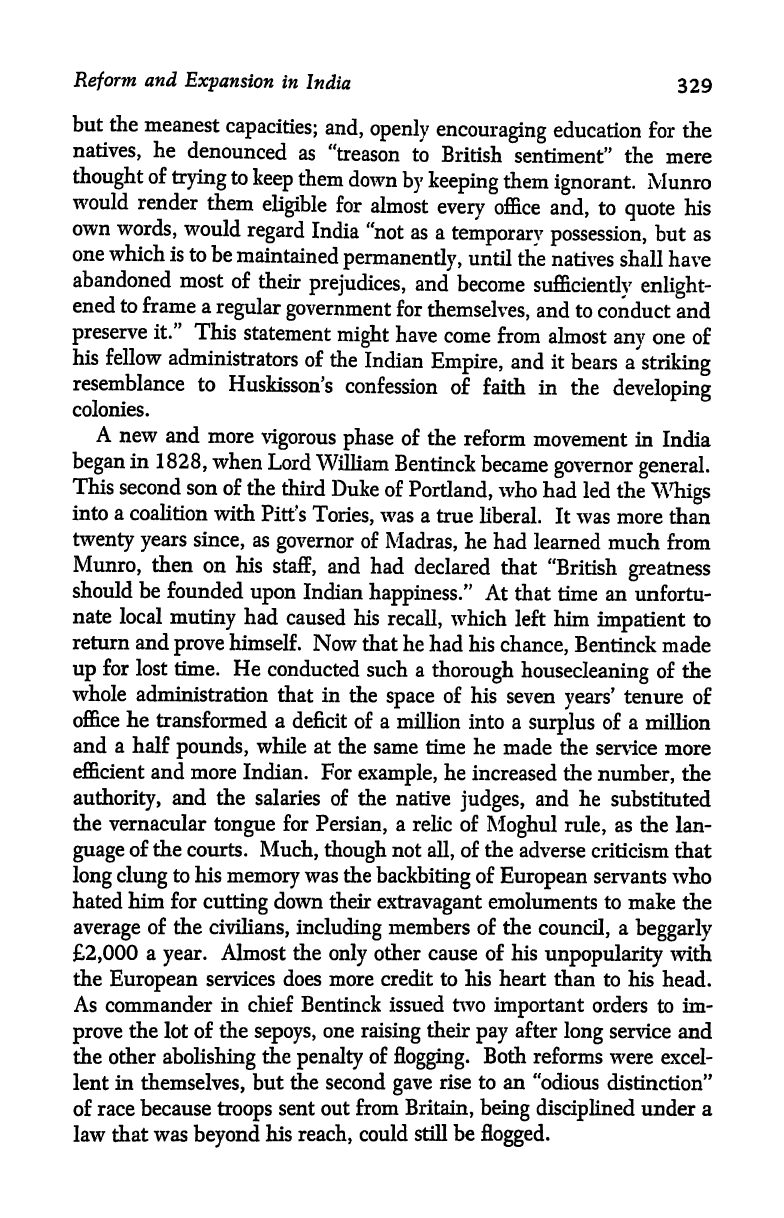
Reform
and
Expansion
in
India
329
but
the
meanest
capacities;
and,
openly
encouraging
education for the
natives,
he
denounced
as
"treason
to
British
sentiment"
the mere
thought
of
trying
to
keep
them
down
by
keeping
them
ignorant.
Munro
would
render
them
eligible
for
almost
every
office
and,
to
quote
his
own
words,
would
regard
India
"not
as a
temporary
possession,
but as
one which
is
to
be
maintained
permanently,
until the
natives
shall have
abandoned
most
of
their
prejudices,
and
become
sufficiently
enlight-
ened
to
frame a
regular
government
for
themselves,
and to
conduct
and
preserve
it."
This
statement
might
have
come
from
almost
any
one of
his fellow
administrators
of
the
Indian
Empire,
and
it
bears
a'striking
resemblance
to
Huskisson's
confession
of
faith
in
the
developing
colonies.
A
new
and
more
vigorous
phase
of the
reform
movement in
India
began
in
1828,
when
Lord
William
Bentinck
became
governor
general.
This
second
son
of
the
third
Duke
of
Portland,
who
had led the
Whigs
into
a
coalition
with
Pitt's
Tories,
was
a
true
liberal.
It
was more
than
twenty years
since,
as
governor
of
Madras,
he
had
learned
much from
Munro,
then
on
his
staff,
and
had
declared that
"British
greatness
should
be
founded
upon
Indian
happiness."
At that
time an
unfortu-
nate
local
mutiny
had
caused his
recall,
which
left him
impatient
to
return
and
prove
himself.
Now that
he
had his
chance,
Bentinck made
up
for
lost
time.
He
conducted such
a
thorough
housecleaning
of the
whole
administration
that
in
the
space
of his
seven
years'
tenure
of
office he
transformed
a
deficit of a
million into
a
surplus
of
a
million
and
a
half
pounds,
while at
the
same time he
made the
service
more
efficient
and more
Indian.
For
example,
he
increased the
number,
the
authority,
and the
salaries of the native
judges,
and he
substituted
the vernacular
tongue
for
Persian,
a relic of
Moghul
rule,
as the
lan-
guage
of
the
courts.
Much,
though
not
all,
of
the
adverse
criticism
that
long clung
to his
memory
was the
backbiting
of
European
servants
who
hated
him for
cutting
down
their
extravagant
emoluments
to
make the
average
of the
civilians,
including
members
of
the
council,
a
beggarly
2,000
a
year.
Almost
the
only
other
cause
of
his
unpopularity
with
the
European
services
does
more credit to his
heart
than
to his
head.
As
commander
in
chief
Bentinck issued two
important
orders
to
im-
prove
the
lot
of
the
sepoys,
one
raising
their
pay
after
long
sendee
and
the other
abolishing
the
penalty
of
flogging.
Both
reforms
were
excel-
lent
in
themselves,
but
the second
gave
rise
to an
"odious
distinction"
of
race because
troops
sent out
from
Britain,
being disciplined
under a
law
that
was
beyond
his
reach,
could
still be
flogged.
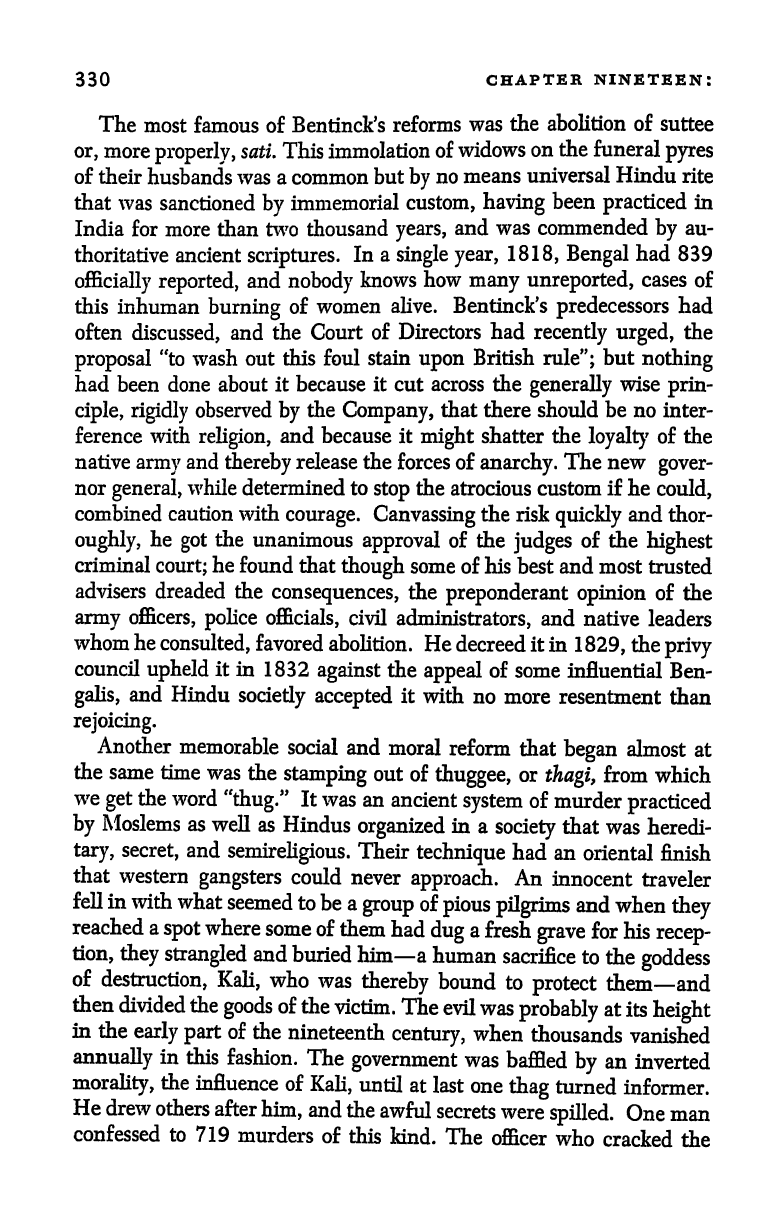
330
CHAPTER
NINETEEN:
The
most famous
of
Bentinck's
reforms
was
the
abolition
of
suttee
or,
more
properly,
sati.
This
immolation
of
widows
on
the
funeral
pyres
of
their
husbands was
a
common
but
by
no
means
universal
Hindu
rite
that
was sanctioned
by
immemorial
custom,
having
been
practiced
in
India
for more than two
thousand
years,
and
was commended
by
au-
thoritative ancient
scriptures.
In
a
single
year,
1818,
Bengal
had 839
officially
reported,
and
nobody
knows how
many unreported,
cases
of
this inhuman
burning
of
women
alive.
Bentinck's
predecessors
had
often
discussed,
and
the
Court
of
Directors had
recently
urged,
the
proposal
"to
wash out
this
foul
stain
upon
British
rule";
but
nothing
had
been
done
about
it
because it
cut
across the
generally
wise
prin-
ciple,
rigidly
observed
by
the
Company,
that
there should
be
no
inter-
ference with
religion,
and because it
might
shatter
the
loyalty
of the
native
army
and
thereby
release the
forces of
anarchy.
The
new
gover-
nor
general,
while determined to
stop
the
atrocious
custom
if he
could,
combined
caution with
courage.
Canvassing
the
risk
quickly
and
thor-
oughly,
he
got
the
unanimous
approval
of the
judges
of the
highest
criminal
court;
he
found that
though
some
of
his
best
and most
trusted
advisers dreaded
the
consequences,
the
preponderant
opinion
of
the
army
officers,
police
officials,
civil
administrators,
and native
leaders
whom
he
consulted,
favored abolition.
He
decreed
it
in
1829,
the
privy
council
upheld
it in
1832
against
the
appeal
of some
influential
Ben-
galis,
and
Hindu
societly
accepted
it
with
no more
resentment
than
rejoicing.
Another
memorable
social and
moral
reform
that
began
almost at
the same
time was
the
stamping
out
of
thuggee,
or
thagi,
from
which
we
get
the
word
"thug."
It
was an
ancient
system
of
murder
practiced
by
Moslems as
well
as
Hindus
organized
in
a
society
that
was
heredi-
tary,
secret,
and
semireligious.
Their
technique
had an
oriental
finish
that
western
gangsters
could never
approach.
An
innocent
traveler
fell in with
what
seemed
to be a
group
of
pious
pilgrims
and
when
they
reached a
spot
where
some
of
them
had
dug
a
fresh
grave
for
his
recep-
tion,
they
strangled
and
buried
him a
human
sacrifice
to the
goddess
of
destruction,
Kali,
who
was
thereby
bound
to
protect
them
and
then
divided the
goods
of
the
victim.
The
evil
was
probably
at
its
height
in
the
early
part
of
the
nineteenth
century,
when
thousands
vanished
annually
in
this
fashion.
The
government
was
baffled
by
an
inverted
morality,
the
influence
of
Kali,
until
at last one
thag
turned
informer.
He drew
others
after
him,
and the
awful
secrets
were
spilled.
One man
confessed to
719
murders
of
this
kind. The
officer
who
cracked
the
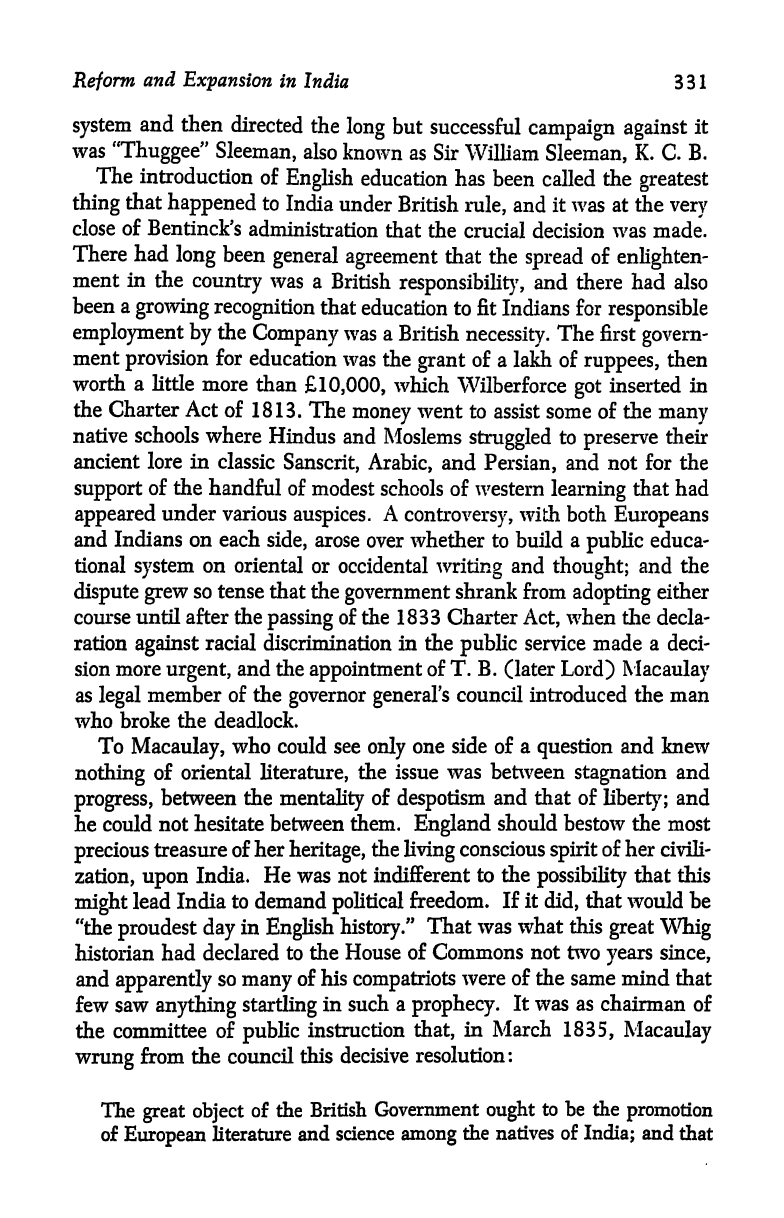
Reform
and
Expansion
in
India
331
system
and then
directed
the
long
but
successful
campaign
against
it
was
"Thuggee"
Sleeman,
also
known
as
Sir
William
Sleeman,
K.
C.
B.
The
introduction
of
English
education
has
been
called
the
greatest
thing
that
happened
to
India
under British
rule,
and
it was at
the
very
close
of
Bentinck's
administration
that the
crucial
decision
was
made.
There
had
long
been
general
agreement
that
the
spread
of
enlighten-
ment in
the
country
was a
British
responsibility,
and there
had
also
been
a
growing
recognition
that
education to
fit
Indians
for
responsible
employment
by
the
Company
was
a
British
necessity.
The
first
govern-
ment
provision
for
education was
the
grant
of a lakh of
ruppees,
then
worth
a
little
more
than
10,000,
which
Wilberforce
got
inserted in
the Charter Act
of
1813.
The
money
went
to
assist some of
the
many
native schools
where
Hindus
and
Moslems
struggled
to
preserve
their
ancient lore
in
classic
Sanscrit,
Arabic,
and
Persian,
and
not
for
the
support
of the
handful
of
modest schools
of
western
learning
that had
appeared
under various
auspices.
A
controversy,
with
both
Europeans
and
Indians
on each
side,
arose
over whether
to
build
a
public
educa-
tional
system
on
oriental or
occidental
writing
and
thought;
and
the
dispute
grew
so tense that the
government
shrank from
adopting
either
course
until
after the
passing
of
the 1833
Charter
Act,
when the
decla-
ration
against
racial discrimination in the
public
service
made
a
deci-
sion more
urgent,
and the
appointment
of
T. B.
(later
Lord)
Macaulay
as
legal
member
of the
governor general's
council introduced
the
man
who broke
the
deadlock.
To
Macaulay,
who
could see
only
one side
of
a
question
and knew
nothing
of oriental
literature,
the
issue
was
between
stagnation
and
progress,
between the
mentality
of
despotism
and that
of
liberty;
and
he
could
not hesitate between
them.
England
should bestow
the
most
precious
treasure of
her
heritage,
the
living
conscious
spirit
of her civili-
zation,
upon
India.
He was
not
indifferent
to
the
possibility
that
this
might
lead
India
to
demand
political
freedom.
If
it
did,
that
would be
"the
proudest
day
in
English
history."
That
was
what
this
great
Whig
historian
had
declared
to
the House
of
Commons
not
two
years
since,
and
apparently
so
many
of
his
compatriots
were of the
same
mind
that
few
saw
anything
startling
in such
a
prophecy.
It was as
chairman
of
the committee
of
public
instruction
that,
in March
1835,
Macaulay
wrung
from the council
this decisive
resolution:
The
great object
of the
British
Government
ought
to
be the
promotion
of
European
literature and
science
among
the natives of
India;
and
that
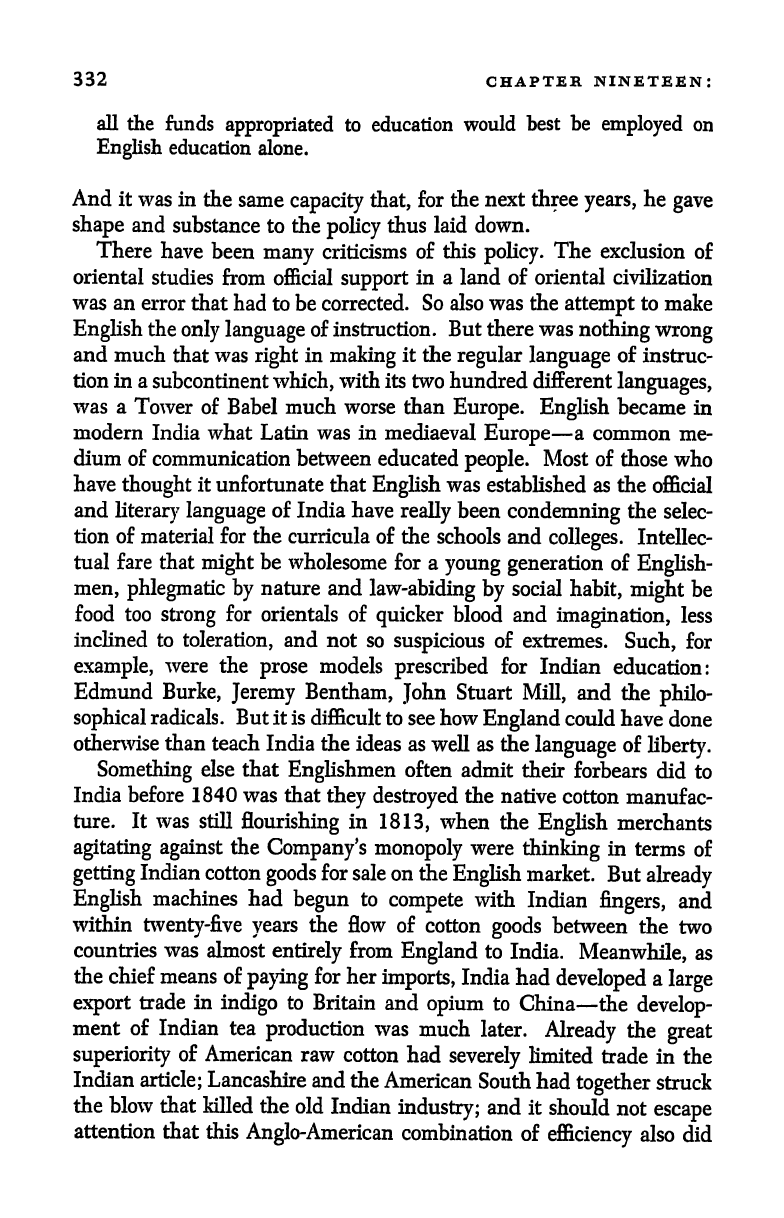
332
CHAPTER
NINETEEN:
all
the
funds
appropriated
to
education
would
best
be
employed
on
English
education
alone.
And
it
was
in
the
same
capacity
that,
for
the
next three
years,
he
gave
shape
and
substance
to the
policy
thus
laid down.
There
have
been
many
criticisms
of
this
policy.
The
exclusion
of
oriental
studies
from
official
support
in
a
land
of
oriental
civilization
was an
error
that
had
to
be corrected.
So also was the
attempt
to
make
English
the
only
language
of
instruction.
But there was
nothing
wrong
and much
that
was
right
in
making
it the
regular
language
of
instruc-
tion in a
subcontinent
which,
with its
two hundred different
languages,
was a
Tower
of Babel
much
worse
than
Europe.
English
became
in
modern India what Latin was in
mediaeval
Europe
a
common me-
dium
of communication between
educated
people.
Most of
those
who
have
thought
it
unfortunate
that
English
was
established as
the
official
and
literary
language
of
India have
really
been
condemning
the
selec-
tion of material
for the
curricula of the
schools
and
colleges.
Intellec-
tual fare
that
might
be
wholesome for
a
young
generation
of
English-
men,
phlegmatic by
nature and
law-abiding
by
social
habit,
might
be
food too
strong
for
orientals of
quicker
blood
and
imagination,
less
inclined
to
toleration,
and not
so
suspicious
of
extremes.
Such,
for
example,
were
the
prose
models
prescribed
for Indian
education:
Edmund
Burke,
Jeremy
Bentham,
John
Stuart
Mill,
and the
philo-
sophical
radicals. But it is
difficult to see
how
England
could
have
done
otherwise
than
teach
India
the
ideas
as
well as
the
language
of
liberty.
Something
else
that
Englishmen
often
admit
their
forbears
did
to
India
before 1840
was that
they
destroyed
the
native
cotton
manufac-
ture. It
was
still
flourishing
in
1813,
when the
English
merchants
agitating against
the
Company's
monopoly
were
thinking
in
terms
of
getting
Indian
cotton
goods
for sale
on the
English
market.
But
already
English
machines
had
begun
to
compete
with
Indian
fingers,
and
within
twenty-five years
the flow
of
cotton
goods
between
the two
countries
was almost
entirely
from
England
to
India.
Meanwhile,
as
the
chief means
of
paying
for
her
imports,
India
had
developed
a
large
export
trade
in
indigo
to Britain
and
opium
to
China
the
develop-
ment
of
Indian
tea
production
was
much
later.
Already
the
great
superiority
of
American raw
cotton
had
severely
limited
trade in
the
Indian
article;
Lancashire
and the
American
South
had
together
struck
the blow that
killed
the
old
Indian
industry;
and it
should
not
escape
attention
that
this
Anglo-American
combination of
efficiency
also
did
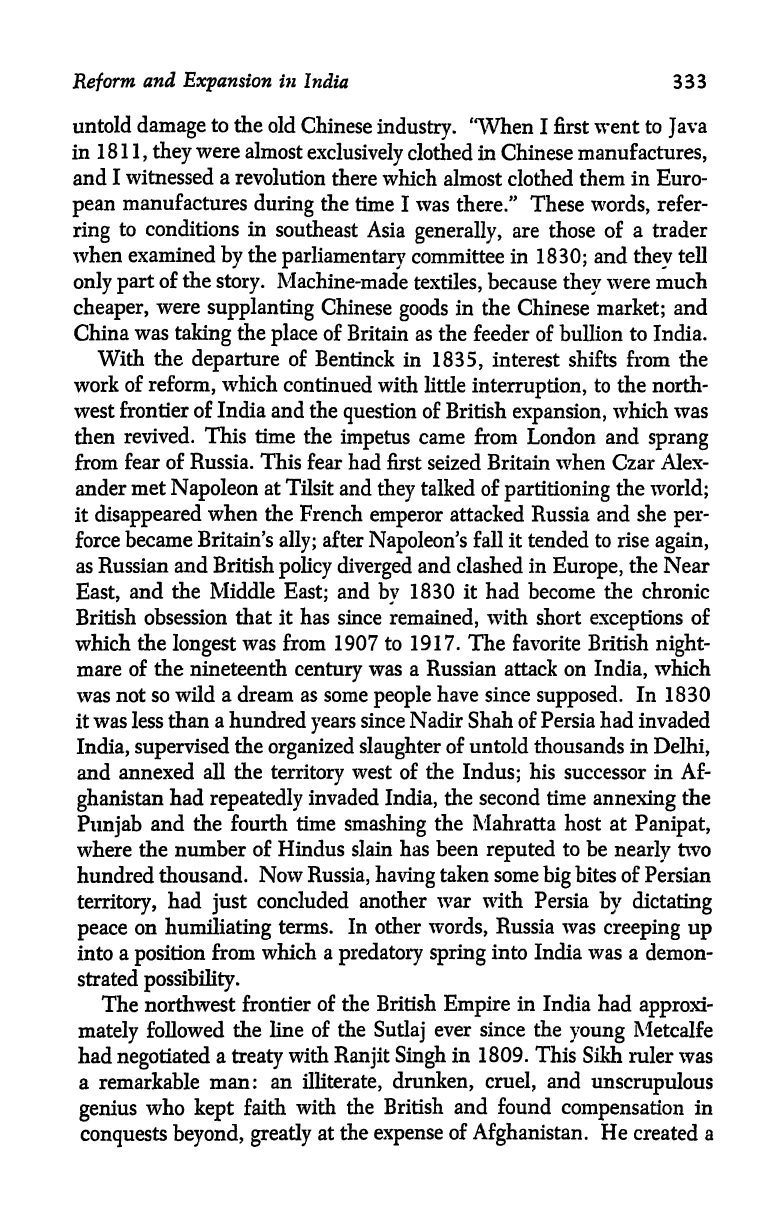
Reform
and
Expansion
in
India
333
untold
damage
to the
old
Chinese
industry.
"When I
first went
to
Java
in
1
8
1 1
,
they
were
almost
exclusively
clothed in Chinese
manufactures,
and
I
witnessed
a
revolution
there
which
almost clothed
them
in
Euro-
pean
manufactures
during
the
time
I was
there."
These
words,
refer-
ring
to
conditions
in
southeast
Asia
generally,
are
those
of
a trader
when
examined
by
the
parliamentary
committee
in
1830;
and
they
tell
only
part
of
the
story.
Machine-made
textiles,
because
they
were much
cheaper,
were
supplanting
Chinese
goods
in the Chinese
market;
and
China
was
taking
the
place
of
Britain as the
feeder
of
bullion
to
India.
With
the
departure
of
Bentinck
in
1835,
interest shifts
from the
work
of
reform,
which
continued with little
interruption,
to the
north-
west
frontier of
India
and
the
question
of British
expansion,
which
was
then
revived.
This time the
impetus
came
from London
and
sprang
from
fear
of Russia.
This fear
had
first
seized Britain when
Czar
Alex-
ander
met
Napoleon
at
Tilsit
and
they
talked
of
partitioning
the
world;
it
disappeared
when
the
French
emperor
attacked
Russia and
she
per-
force
became
Britain's
ally;
after
Napoleon's
fall it tended
to rise
again,
as Russian
and
British
policy
diverged
and clashed
in
Europe,
the Near
East,
and the Middle
East;
and
by
1830 it had become
the
chronic
British
obsession
that
it has since
remained,
with
short
exceptions
of
which
the
longest
was from 1907 to
1917.
The favorite British
night-
mare
of the
nineteenth
century
was a Russian
attack
on
India,
which
was not
so wild
a dream as
some
people
have
since
supposed.
In
1830
it
was
less
than
a hundred
years
since Nadir
Shah of
Persia had
invaded
India,
supervised
the
organized
slaughter
of untold thousands in
Delhi,
and
annexed
all
the
territory
west
of
the
Indus;
his successor in
Af-
ghanistan
had
repeatedly
invaded
India,
the
second time
annexing
the
Punjab
and the
fourth
time
smashing
the Mahratta host
at
Panipat,
where the
number
of Hindus slain
has
been
reputed
to
be
nearly
two
hundred
thousand.
Now
Russia,
having
taken some
big
bites of
Persian
territory,
had
just
concluded another
war with
Persia
by
dictating
peace
on
humiliating
terms.
In other
words,
Russia
was
creeping up
into
a
position
from
which a
predatory
spring
into
India
was
a
demon-
strated
possibility.
The
northwest
frontier
of the
British
Empire
in
India
had
approxi-
mately
followed
the line of
the
Sutlaj
ever since the
young
Metcalfe
had
negotiated
a
treaty
with
Ran
jit
Singh
in
1809.
This
Sikh
ruler was
a
remarkable
man:
an
illiterate,
drunken,
cruel,
and
unscrupulous
genius
who
kept
faith
with
the
British and
found
compensation
in
conquests
beyond,
greatly
at
the
expense
of
Afghanistan.
He
created
a

334
CHAPTER
NINETEEN:
compact
though
composite
kingdom
comprising
the
Punjab
and Kash-
mir.
There
the
Sikhs,
a
fighting
minority,
ruled
a
population
divided
almost
equally
between
Hindus
and
Moslems.
To
the
southwest
lay
Sind,
the land
of
the
lower
Indus,
separated
from
the rest of
the
country
on
the east
by
the
Thar
or
Indian
desert.
1
Sind
was a
strategic
region,
containing
the
crossroads
of
the
northwest,
for
at
right
angles
to
the
great
river ran the
roads
to
the
southern
mountain
passes
into
Afghanistan;
it was
held
by
rather
weak
hands,
being
divided
among
chieftains or
amirs,
one
of
whom
had
a
shadowy
claim
to
a
shadowy
suzerainty
over
the others.
Ranjit
Singh
coveted
Sind,
and
in 1831
he
proposed partitioning
it
with
the East India
Company.
Bentinck
re-
pelled
the
proposal
and
made
a
treaty
with
the
amirs in
1832,
which
gained
for
Indian
merchants
and
traders
the
right
of
passage
for them-
selves
and their
goods
along
the rivers
and
roads
of
Sind
on
condition
that
no
military
stores
or
armed
vessels
pass
through
the
country
and
no
English
merchant
settle
in
it,
and which
bound
the
two
contracting
parties
"never to
look
with the
eye
of
covetousness
on
the
possessions
of
each other."
From 1834
to 1836
Ranjit Singh
threatened
to
seize
Sind
by
himself,
but
the Indian
government
blocked
him
with
a
warning
and
early
in 1838
persuaded
Sind,
in
return for
the
protection
given,
to
admit
a British resident.
Afghanistan,
which
lay beyond
these two
states,
had fallen
upon
evil
days.
After
being long
a
prey
of
anarchy,
which left
it
divided into
three
principalities,
it
was
caught
in a double
squeeze
between
Ranjit
Singh
on the one
side
and the
shah of
Persia
on die
other,
each
seeking
to
recoup
himself
there for
territory
denied
by
Britain or lost
to Russia.
Persia
having
fallen
under Russian
sway,
a
Persian
army
that was
trained
and officered
by
Russians
invaded
Afghanistan
and
laid
siege
to
Herat,
the seat of the western
principality,
late in 1837.
The ruler
of the eastern
principality'
of
Kabul,
Dost
Mohammed,
had
already
appealed
to
the British for aid
against
Persia
and
against Ranjit
Singh,
from
whom he
wanted to
recover the
state of
Peshawar;
and
getting
an unfavorable
reply
from
Calcutta,
he threw
himself
on the side
of
the
Russo-Persian
combination. If Herat
fell,
the
whole
of
Afghanistan
might
fall to
the
Russians,
and this
might
shake the British
position
in
India
by
damaging
the
prestige
on which it
was
built.
Lord
Auckland,
Bentmck's
inept
successor,
determined to restore the
lost
balance
in
Afghanistan by
backing
a
scheme to restore Shah
Shuja
to
the throne
1
Also
isolated
on
the west
by
a
desert.
